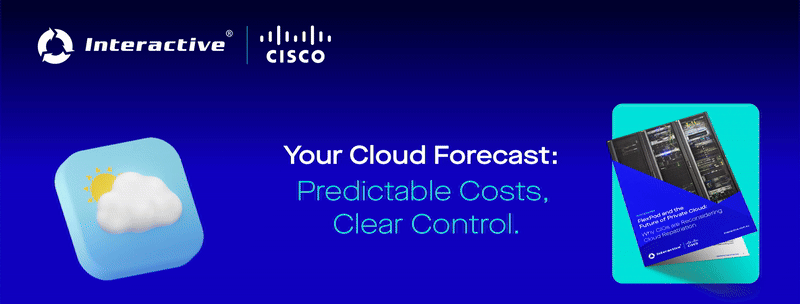Cost of Cloud: How hyperscaler pricing is pushing businesses toward repatriation

Like their CFO counterparts, CIOs are keeping a sharp eye on the bottom line. They have to in this day and age. In fact, CIOs are no longer simply tech leaders; they’re business leaders – and they need to be financially savvy out of necessity. Today, they’re learning the language of risk, cost and return.
Certainly, as cloud adoption matures, IT leaders across all sectors – from healthcare to finance to government – are peeling back the layers and taking a closer look at the true cost of cloud services.
While public cloud has long been seen as a flexible and scalable solution, many IT leaders are now confronting rising hyperscaler costs, hidden fees, and increasing complexity.
The result? A growing movement toward cloud repatriation, which is the strategic decision to move workloads from public cloud environments back to on-premises infrastructure or private cloud solutions.
This shift isn’t about rejecting digital transformation. Instead, it’s about ensuring long-term cost control, compliance, and performance in an increasingly regulated and unpredictable IT landscape.
“More and more repatriation projects are underway as enterprises continue to receive exorbitant cloud bills. Many enterprises now realise that the unexpectedly high costs of cloud services are unsustainable in the long term,” according to information in InfoWorld, which touches on cost-conscious cloud repatriation strategies.
It’s no surprise then that CIOs have joined their executive peers in scrutinising every dollar spent – especially when it comes to technology, which is why cost-driven decisions like cloud repatriation are becoming increasingly common.
Analysts are also weighing in. Insights from Gartner’s IT Infrastructure, Operations and Cloud Strategies conference highlight a critical factor driving this shift.
While cost is often cited as a driver, Gartner suggests it’s not simply that public cloud is inherently too expensive. Instead, many organisations are realising they underestimated the hidden costs, particularly around data egress. In many cases, it’s not clear what systems are communicating with each other, or in which direction data is flowing, leading to unexpected charges and architectural missteps.
Ultimately, cloud repatriation reflects a growing maturity in how enterprises approach cloud strategy. It’s not about abandoning the cloud – it’s about using it smarter. Read our comprehensive guide here.
True cost of hyperscaler cloud services
So, let’s talk pricing. Hyperscalers – public cloud providers including AWS, Microsoft Azure, and Google Cloud – offer scalable platforms that have powered much of the world’s digital growth.
But the pricing models that once attracted businesses are now under scrutiny.
Here’s why:
- Steep price increases: Hyperscalers have implemented multiple price hikes in recent years, particularly around outbound data transfer, storage tiers, and high-performance workloads.
- Inconsistent regional pricing: Prices for the same services can vary significantly across geographies, making budgeting and cost predictability a challenge.
- Hidden costs: From tiered support services and API call charges to complex storage class fees and third-party integrations, cloud bills often grow unpredictably.
- Difficulty in workload optimisation at scale: What appears cost-effective at the start often becomes burdensome at scale, especially when workloads aren’t optimally configured or usage patterns fluctuate.
Certainly, the impact of these factors is forcing CIOs, CFOs, and IT operations leaders to ask a difficult question: Is public cloud still the most cost-effective option for every workload?
Why are organisations considering cloud repatriation?
As we’ve learned, cost alone doesn’t drive repatriation. If anything, businesses are discovering that for certain workloads, private or hybrid environments offer not just savings, but also performance gains, improved control, and compliance advantages.
Common reasons for repatriation include:
Unsustainable Costs
Many businesses are seeing cloud bills climb year-on-year without a matching uplift in business value. Hidden charges, including data egress and underutilised services escalate the problem.
Performance and Optimisation at Scale
Typically some workloads, especially those that are latency-sensitive or require consistent performance, run more efficiently on-prem or in hybrid setups. Organisations are also struggling to optimise workloads at scale in the public cloud, leading to inefficiencies.
Data Sovereignty and Compliance
Heavily regulated industries, including finance, healthcare, and government, must meet strict data residency, privacy, and security requirements. Hosting workloads in sovereign or Australian-based private infrastructure helps meet standards – including APRA CPS 230 – and other state and federal data laws.
Vendor Lock-in and Loss of Flexibility
Over-reliance on a single hyperscaler limits control over pricing, architecture, and long-term strategy. Repatriation provides a chance to rebalance and regain autonomy.
Benefits of cloud repatriation for cost management
Repatriating workloads can unlock a range of financial and operational benefits, including:
- Improved cost visibility and forecasting: Fixed infrastructure and managed service costs are often easier to budget than variable cloud expenses.
- Reduced reliance on third-party tools: On-premises or private cloud environments can consolidate functions that might otherwise require additional paid services in public cloud.
- Optimised resource utilisation: Organisations can right-size infrastructure to fit workload needs, which means eliminating underused or overprovisioned resources.
- Control over upgrade and support timelines: Businesses are no longer bound to a vendor’s roadmap or sudden feature changes tied to cost increases.
Place for internal quote: Lorem ipsum dolor sit amet, consectetur adipiscing elit. Curabitur a erat a neque varius pretium. Fusce in tristique metus. Sed pellentesque convallis nulla, sit amet elementum est facilisis a.
Industry examples of cost-driven repatriation
Media and Content Providers
With massive data workloads and continuous streaming demands, media companies have found hyperscaler costs unsustainable. By shifting high-volume workloads to private cloud platforms, they gain both cost control and performance consistency.
Financial Services
Banks and insurers are repatriating transaction-heavy systems to meet latency, compliance, and cost goals. In fact, they are often leveraging hybrid IT models for optimal flexibility.
Manufacturing
Enterprises in manufacturing are bringing critical workloads closer to operations for real-time data processing, edge computing, and better control over licensing and operational costs.
These are just some examples – have you considered the benefits in your industry?
Repatriation considerations in heavily regulated industries in Australia
Notably, Australia is home to a significant number of heavily regulated industries – particularly those where public safety, financial stability, and data protection are critical.
This means CIOs need to ask this important question: What are some of the things to think about when repatriating in heavily regulated industries in Australia? Here’s a run-down.
Key considerations include:
Compliance alignment:
Ensure any new infrastructure, whether on-prem or private cloud, meets relevant standards such as APRA CPS 230, IRAP, ISO 27001, and other sector-specific frameworks.
Data sovereignty
Keep workloads within Australian jurisdiction to comply with local data residency and privacy laws.
Security architecture
Reassess perimeter, endpoint, and identity controls to match the new environment and protect sensitive workloads.
Resilience and continuity
Design with high availability, redundancy, and disaster recovery in mind, particularly for mission-critical applications.
Stakeholder alignment
Engage compliance, risk, legal, and executive sponsors early to avoid roadblocks and ensure shared accountability.
Rethink cloud with Interactive
At Interactive, we help organisations rethink their cloud strategies, not to slow down transformation, but to make it smarter, more cost-effective, and aligned with business goals. Our team supports clients across industries with:
- Cloud cost audits and optimisation plans
- Repatriation strategy development
- Private cloud and managed hosting solutions
- Hybrid IT architecture and ongoing support
Whether you’re exploring repatriation or looking to fine-tune your cloud mix, Interactive delivers the infrastructure expertise, local support, and regulatory understanding to help you move forward with confidence.
Frequently Asked Questions
What is cloud repatriation?
Cloud repatriation refers to the process of moving workloads from public cloud platforms back to on-premises infrastructure or private cloud environments. It’s often for reasons of cost, performance, or compliance.
Why is the cost of public cloud rising?
Hyperscalers are increasing prices for data transfer, support tiers, storage classes, and usage-heavy services. These incremental charges add up and can result in unpredictable billing.
Is cloud repatriation only for large enterprises?
No. Mid-sized businesses and even startups in regulated sectors are also considering repatriation as part of a broader hybrid IT strategy to manage costs and improve control.





